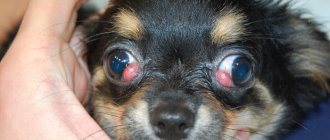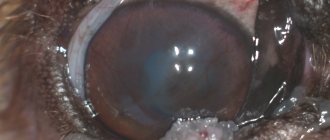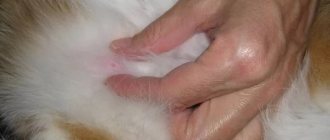Anatomy of the prostate gland
The prostate gland (prostate) is an accessory sex gland in males, performing a secretory function; it is the only accessory sex gland in males.
The prostate surrounds the proximal urethra at the bladder neck, and its ducts flow into the urethra in a circumferential manner. On the dorsal surface it is divided into two lobes with a septum in the middle. The prostate gland does not contain microorganisms. The function of the prostate gland is to produce secretion, which is a supporting and transporting medium for sperm during ejaculation.
Also, seminal fluid mechanically dilutes the sperm produced by the testes, increases the volume of ejaculate, and promotes the movement of viable sperm outside the male body. Basal secretion of small amounts of secretion leads to its constant entry into the excretory ducts and the prostatic part of the urethra.
The hormone testosterone is required to maintain the size and growth of the prostate gland. When a male dog is castrated before puberty, normal prostate growth is suppressed. When a male dog is castrated as an adult, the gland involutes up to 20% of its normal size in an adult animal.
Causes
Prostatitis is a disease that occurs in dogs of any age, but more often it appears after reaching 7 years of age. It is often caused by pathological processes in organs located near the prostate gland and hormonal imbalances.
Causes of prostatitis in dogs:
- hormonal disorders, uncontrolled treatment with hormonal drugs;
- diseases of other internal organs: proctitis, urethritis or colitis;
- infectious pathologies;
- bacterial infections;
- long-term improper treatment of various diseases;
- penile injury;
- lack of hygiene of the dog’s genital organ;
- predisposition;
- lack of physical activity;
- reduced immunity.
The consequence of prostatitis is an enlargement of the prostate gland beyond normal. Because of this, blood circulation in the tissues of the organ slows down, and favorable conditions for the proliferation of microbes develop.
Diagnosis of prostate diseases
- Anamnesis collection.
- Examination with rectal palpation.
- Cytological examination of any discharge from the urethra.
- Analysis of urine.
- Biochemical and clinical blood test.
- X-ray examination.
- Cytoloic and microbiological study of prostate secretion.
- Ultrasonography.
- Aspiration or percutaneous biopsy.
History taking
It is necessary to collect a complete history, take into account the main complaint and the general condition of the patient. Pay attention to the state of urination and defecation.
Physical examination (prostate palpation)
It is advisable to use the two-handed method. The prostate gland is palpated with a finger through the rectum, in the ventral part of the pelvic canal. During palpation, it is necessary to evaluate the size, consistency, symmetry, contours, whether it is fixed or removable. Physical examination of the prostate gland through the rectum can be facilitated by simultaneous palpation of the caudal part of the abdominal cavity, pressing on which can displace the gland more caudally along the pelvic canal. Normally, a healthy gland is smooth, symmetrical, and painless.
Urinalysis and bacteriological culture
Detection of hematuria, bacteriuria/pyuria in the urine analysis of an uncastrated male dog can always indicate the possibility of prostate diseases.
If an infectious process in the prostate is suspected, it is recommended to take sperm or urine for bacteriological examination. In this case, urine can be taken for bacteriological culture in several ways:
1) By cystocentesis (the gold standard for culture testing for urinary tract infections), but it should be taken into account that urine culture may be falsely negative if the prostatic secretion has not contaminated the contents of the bladder.
2) By taking a mid-portion of urine (in this case, possible contamination of pathogenic microflora from the distal part of the urethra should be taken into account).
Blood tests
Blood tests are necessary to exclude systemic diseases and screen for hidden diseases in aging animals.
Serological tests designed specifically for the diagnosis of prostate diseases are currently not available.
Cytological examination of any urethral discharge
Discharge from the urethra
If prostate disease is suspected, it is necessary to examine the secretion of the gland in a male dog in order to determine the cause of the pathological process.
Any discharge from the urethra should be examined microscopically.
Bacteriological culture of the urethra should not be performed due to the presence of bacterial flora in the distal part of the urethra.
Sperogram
In males, sperm consists of 3 fractions
- Urethral
- Spermatic
- Prostatic.
For diagnostic purposes, 2-3 ml of the third fraction is collected. For the accuracy of the result, cytological and cultural examination is required, since bacterial flora is normally present in the distal part of the urethra.
With diseases of the testes and appendages, the appearance and color of the ejaculate may change.
The prostatic secretion of a healthy dog contains a small amount of leukocytes, epithelial cells, and bacteria. Sperm pH 6.0-6.7.
Deviations during the study:
- a large number of leukocytes.
- a large number of red blood cells
- bacteria in large numbers located inside leukocytes and macrophages.
-macrophages containing hemosiderin.
When culturing the ejaculate, a large number of gram-negative microorganisms in combination with a large number of leukocytes indicates an infectious process, unless the sample was contaminated with preputial contents during collection.
In cases of suspected prostate neoplasm involving the prostatic urethra, the likelihood of the presence of atypical cells in samples obtained from prostate massage is greater compared with the likelihood of their presence in the ejaculate.
Radiography
X-rays provide information about the size and location of the prostate gland. The photographs can reveal its increase. However, radiography is of limited benefit. In many cases, palpation of the prostate can provide more accurate results.
For dysuria in dogs, the test of choice for prostate disease is remote retrograde urethrocystography.
With asymmetry of the prostate in relation to the urethra, narrowing of the prostatic part of the urethra, the following are most likely: abscess formation, parenchymal cysts, neoplasms, hyperplasia. If the X-ray shows marked enlargement of the prostate, presumably due to a neoplasm, radiographs of the chest and abdomen should be examined for signs of metastasis.
Ultrasonography
Ultrasound diagnostics is the best method for assessing the prostate gland. In this case, it is possible to determine the size and homogeneity of the prostate tissue.
The prostate parenchyma is homogeneous, of medium echogenicity with fine or medium granularity and smooth edges. In the sagittal projection, the shape of the organ is round or oval; in the transverse projection, it is estimated that both lobes are symmetrical.
The prostatic part of the urethra with its surrounding muscles and vertical suture is visualized as a hypoechoic structure located between the two lobes. Ultrasound diagnostics can determine the presence of inflammation of the prostate, abscess, prostate cysts, and prostate tumors.
It is necessary to examine the sublumbar lymph nodes. During infectious processes or neoplasms, their increase or change in echogenicity may be observed.
Prostate biopsy
Under ultrasound control, a needle aspiration biopsy (14-18 G biopsy needles) is performed from intraprostatic cavity lesions to collect cellular material for cytological examination. When receiving an aspiration biopsy, the prostatic fluid should be examined microscopically, as well as bacteriological culture to detect pathogenic microflora.
The most common complication of prostate biopsy is mild hematuria, but significant bleeding is also possible. To avoid complications, before performing a biopsy, it is recommended to take a test to study the patient’s blood clotting - a coagulogram.
1. Percutaneous biopsy. Conducted via transabdominal access under ultrasound guidance, the animal is under sedation.
2. Surgical biopsy. X surgical biopsy is performed using a biopsy needle by wedge-shaped resection of the parenchyma. Before performing a biopsy, cysts or areas of potential abscess should be aspirated. A sample of sublumbar lymph nodes should also be taken.
Urethroscopy
The prostatic urethra can be visualized using urethroscopy. In this case, it is possible to visualize the flow of exudate or bleeding into the prostatic part of the urethra and exclude non-prostate urethral lesions as the cause of urethral discharge.
Prostate inflammation and proper treatment in dogs
Prostatitis in dogs is a common pathology; it occurs, as is clear, in males. The disease is serious and leads to suffering for the animal and great stress and trouble for the dog owner. In the article we will look at the features of this pathology and find out what are the causes and symptoms of prostatitis in dogs. Let's find out how to treat prostatitis and what can be done to prevent the disease.
Prostatitis is an inflammatory process in the prostate gland. The disease occurs in dogs over the age of five years.
The pathology is serious, dangerous, and can lead to serious consequences: that is why the disease requires mandatory diagnosis and urgent treatment.
The symptoms of the disease can be confused with cystitis, so in this case only a veterinarian should make a diagnosis and prescribe treatment.
The immediate cause of the disease in a dog is a bacterial infection that has penetrated the genitourinary organs. Sometimes the cause of the disease is some autoimmune pathology, which is very difficult to diagnose and treat.
Theoretically, a dog of any age can get prostatitis, but dogs that are 5-7 years old are more likely to get sick. This pathology can be caused by many reasons, but more often these are pathological inflammatory processes in the pelvic organs, as well as hormonal disorders. Let's look at the main reasons that cause this disease in dogs.
These are various hormonal disorders in the body, or illiterate treatment of the dog with hormonal drugs, or exceeding the dose of such drugs.
Diseases of internal organs: colitis, urethritis, proctitis negatively affect the condition of the prostate in dogs. Pathologies of an infectious nature can also be the cause of the disease. If the dog was misdiagnosed and treated for a long time with the wrong medications, this fact can also cause the disease.
Lack of hygiene procedures, the dog being in the dirt, among garbage, rubbish and in similar unsanitary conditions. Sometimes individual predisposition plays a role.
If a dog is inactive, it is more susceptible to prostatitis. Low immunity is also one of the main reasons.
The disease leads to an increase in the volume of the animal's prostate gland. This fact leads to a slowdown in blood circulation and the creation of favorable conditions for the proliferation of bacteria.
Course of the disease and symptoms
Prostatitis in a male dog can be either acute or chronic.
In the acute form, the disease manifests itself with the following symptoms:
- high temperature (up to +40 degrees);
- headache;
- nausea, vomiting;
- difficulty with bowel movements;
- loss of appetite;
- frequent urination with blood;
- difficulty urinating;
- severe pain;
- stiffness of the dog’s gait;
The animal may experience feverish conditions: permanent or temporary. The gait takes on “wooden” characteristics and the dog becomes inactive. Possibly indigestion in the form of constipation and diarrhea. A pet may lose a lot of weight during its illness. Sometimes the dog spends hours trying to perform the act of urination, but to no avail.
In addition to the above, a dog infected with this disease is likely to become infertile. That is, such a male cannot be used for breeding.
If you notice the listed symptoms in your dog, you need to take your pet to a veterinarian. The sooner the diagnosis is made and treatment begins, the more likely it will be to prevent possible complications of prostatitis. Note that although the acute form can be treated more quickly, it often leads to complications in the form of dangerous abscesses or even purulent peritonitis.
The chronic course of the disease does not have such pronounced symptoms.
Most often, with a similar course of the disease, the dog periodically feels pain when urinating, but outwardly this fact does not manifest itself in any way and is invisible to the owner of the animal.
In general, the dog’s condition is normal - the animal eats as usual, is quite active and cheerful. This lack of symptoms makes early detection of chronic prostatitis very difficult, which sometimes leads to serious consequences.
Chronic prostatitis in a dog can only be detected by examination by a veterinarian. Therefore, every pet owner should make it a habit to regularly examine their pet at the veterinary clinic, regardless of whether there are any alarming symptoms or not.
Diagnosis of prostatitis
When examining a dog, diagnosing prostatitis in some cases is quite difficult. Often this disease has symptoms similar to those of cystitis, urethritis, and tumor formations.
The disease is diagnosed using the following methods:
- direct palpation of the prostate gland;
- study of biomaterials (potassium and urine);
- Ultrasound of the pelvis;
- examination of the prostate gland through the rectal opening;
The presence/absence of certain symptoms can also point the diagnosis in the right direction.
Since the symptoms of prostatitis are similar to those of many other diseases, additional examinations are sometimes required to make an accurate diagnosis.
Prostatitis of the chronic type is especially difficult to diagnose; in this case, sometimes the dog even has to undergo a biopsy.
Please note that the biopsy procedure is quite complex and dangerous, so it is performed only if there is no other way to correctly diagnose the dog’s condition.
In case of illness, it is important to diagnose this pathology in a timely manner. This way, treatment will be prescribed in a timely manner, which will save the reproductive and general health of the pet.
Necessary treatment of the prostate in a dog
It is important to begin treatment for prostatitis in dogs as early as possible.
If you delay in starting therapy, the disease may progress into the chronic phase, when the symptoms will be less pronounced and the treatment itself will be more difficult.
In the acute course of the disease, the dog, as a rule, feels very unwell, and its malaise is noticeable to the naked eye. Without proper care and treatment, the dog may even die.
Prostatitis is usually treated with antibiotics: the dog must take antibacterial drugs for three weeks.
The drug is prescribed after examinations: the antibiotic drug must correspond to those pathogens that are directly “culpable” for the pathology of a particular dog.
The most effective antibiotics for treating canine prostatitis are:
- clindamycin;
- trimethoprim;
- erythromycin;
- chloramphenicol.
In addition to the above, drugs from the group of quinolones and sulfonamides are also effective. If the case is severe and advanced, intravenous infusions of special nutrient solutions, as well as buffer (barrier) solutions, are used. These substances help eliminate or reduce the symptoms of intoxication.
In addition to antibiotics, non-steroidal anti-inflammatory drugs are used to quickly rid the dog of infection. However, long-term therapy with these drugs is prohibited, since they strongly damage the immune system. If there is a high temperature or pain, symptomatic treatment with appropriate antipyretic drugs and analgesics is prescribed.
Completion of treatment
When the course of treatment comes to an end, it will be necessary to take tests again to detect any remaining pathogens. If any are detected, the course of therapy will have to be extended.
After the dog has fully recovered, a repeat control examination is scheduled six months after the end of treatment.
If treatment with the prescribed drug does not produce results, the veterinarian prescribes another drug.
If, after two weeks of therapy, no significant improvement in the dog’s condition is noticed, and the level of leukocytes in the blood only increases, most often a decision is made to castrate the animal.
This extreme measure allows you to avoid serious and sometimes fatal complications. Note that young dogs with prostatitis recover easier and faster than adult dogs.
Young animals are rarely castrated; usually dogs over five years old undergo this operation.
If medical care was provided correctly and in a timely manner, then with acute prostatitis the dog recovers already on the 12th day of treatment. A mild form of the disease is treated at home, but a severe form is treated in a hospital.
Treating chronic prostatitis in dogs is more difficult than acute prostatitis. Sometimes it is even necessary to castrate the animal if the chronic course of the disease leads to complications. Chronic prostatitis leads to rupture of the prostate abscess; in this case, surgical intervention is required urgently. Even the most experienced surgeon cannot guarantee a positive treatment outcome.
If the case is not very severe, and the dog was sent for home treatment, you should see a veterinarian every week or two. This measure will help to adjust treatment in time. If prostatitis is chronic, then the dog should be under veterinary control for at least a month: this will help prevent relapses and complications of the disease.
https://www.youtube.com/watch?v=trPFoypCgyM
Pay attention to the color of the dog's urine: the lighter the liquid becomes, the better the animal's condition becomes. When the urine becomes clear and light, as before the disease, we can talk about the animal’s complete recovery.
Diseases of the prostate gland in males
Prostatitis, prostate abscess
Prostatitis is a nonspecific inflammation of the prostate gland. There are acute and chronic prostatitis. The most common causative agents of infection are Escherichia coli, staphylococci, and streptococci. The development of a chronic process is facilitated by the accumulation and stagnation of prostate secretions. Pathogenic microflora enters the prostate tissue ascendingly from the urethra. Most often, a prostate abscess occurs after incomplete cure of acute prostatitis.
Abscesses develop when the infection is severe and pus is encapsulated.
Abscess formation is the result of chronic infection.
The source of infection of the prostate gland is usually the urethra. The inflammatory process can spread to the overlying parts of the urinary tract, which causes damage to the bladder, ureters and kidneys.
Symptoms: Difficulty urinating (stranguria), bloody or purulent discharge from the urethra, tenesmus, fever, anorexia, difficulty defecating.
Diagnosis: To make a diagnosis, an animal's medical history, a general clinical blood test, a biochemical blood test, a urinalysis and urine culture results, and an assessment of prostate secretions are collected.
Treatment: The antibiotic selected based on culture results should be used for at least 28 days.
Castration is beneficial and may be a necessary condition for resolving a chronic infectious process in the prostate gland.
Prostate abscesses require surgical drainage. Drainage is carried out under an ultrasonic king.
Benign hyperplasia, cystic hyperplasia
Benign prostatic hyperplasia is an increase in the number and size of epithelial cells. Prostatic hyperplasia is the most common pathology of the prostate gland. Almost 100% of uncastrated males, starting from 2.5 years of age, develop signs of prostatic hyperplasia as they age. This is a hormone-dependent process associated with a violation of the ratio of androgens and estrogens, and occurs exclusively in the presence of testes. Due to hyperplasia, intraparenchymal fluid cysts may develop. Most often, this pathology manifests itself over the age of 4 years.
Symptoms: In most male dogs, the lesion may be asymptomatic. Sometimes there may be bloody discharge from the urethra, hematuria, hematospermia.
Diagnosis: Ultrasound diagnosis, prostate biopsy. The diagnosis is confirmed by a positive response to castration.
Treatment: There are several treatments for prostatic hyperplasia.
- Surgical castration results in a 75% reduction in prostate size within 8-10 weeks.
- Chemical castration involves the use of estrogens or antiandrogens.
Hormone therapy in the form of estrogen is rarely used due to a number of side effects, toxic effects on the body, bone marrow suppression, and the development of diabetes.
Antiandrogens do not cause a number of side effects, unlike estrogens. There are drugs licensed for veterinary use.
At the moment, antiandrogens are the therapeutic choice of the veterinarian.
Prostate neoplasms
In older animals, the prostate gland is susceptible to neoplastic transformation.
Most often these are malignant neoplasms. The prostate can be the site of metastasis or the site of primary formation. There are such neoplasms as: carcinoma, transitional cell carcinoma, adenocacyoma, lymphosarcoma, squamous cell carcinoma and hemangiosarcoma. Benign prostate tumors, such as leiomyoma, are rare.
Symptoms: Enlarged prostate on rectal examination, asymmetrical prostate gland. Difficulty urinating and defecating, urethral obstruction.
The tumor can grow into the bladder neck and can cause ureteral obstruction.
Pathological changes in urine and hematuria predominate.
Diagnosis: If a male dog was neutered at a young age and has obvious enlargement of the prostate gland, it is most likely that the enlargement may be due to a neoplasm.
To check for the presence of metastases in the lungs, it is necessary to conduct an x-ray of the organs of the ore cavity.
The bodies of the lumbar vertebrae and pelvic bones should be examined to identify foci of proliferative changes that suggest the presence of metastases.
It is necessary to conduct ultrasound diagnostics. In non-castrated males with a noticeable enlargement of the prostate gland, the neoplasm should be differentiated from prostate abscessation and paraprostatic cysts. To establish a diagnosis, a prostate biopsy is necessary. The final diagnosis is made based on cytological or histopathological examination of prostate tissue samples.
Treatment: There is no effective treatment for prostate cancer.
Sometimes, in the absence of metastases, surgery can be performed to completely remove the prostate. But owners should be warned about the likely development of urinary incontinence after surgery. The goal is usually temporary tumor control and relief of clinical signs. Castration leads to a slight positive effect.
Symptoms and first signs of the disease
There are quite characteristic symptoms and the first signs of the disease, which should serve as a reason to contact a veterinary clinic.
- Discoloration of urine red or brown. The proliferation of prostate tissue leads to disruption of the blood supply to the organ and disruption of the integrity of the small capillaries. As a result, droplets of blood enter the urethra and give the urine a reddish tint of varying intensity.
- Lameness and changes in gait. The growing gland puts pressure on neighboring organs, causing pain that affects the position of the hind limbs.
- Difficulty urinating , resulting from compression of the urethra and the inability to freely exit urine.
- Constipation, painful and strained bowel movement. Compression of the rectal adenoma first leads to a change in the shape of the excreted feces. It can be flattened or thread-like. The progression of the disease leads to the formation of rectal diverticula, where a large amount of feces accumulates, which can no longer pass independently through the closed intestinal lumen.
Diagnostic methods
There are two methods for diagnosing this disease:
- Rectal palpation. The veterinarian inserts a finger into the anus and feels the tumor. The adenoma is painless, and the prostate gland itself is mobile and enlarged, hard to the touch.
- Ultrasound. Using this test, the veterinarian evaluates the shape, size and density of the tumor.
REFERENCE! X-ray can exclude other diseases of the prostate gland: abscess, prostatitis, cancerous tumors. Also, with the help of this study, the veterinarian evaluates the size of the lymph nodes.
Prevention of prostatitis
To prevent the development of prostatitis in a male dog, you need to remember the rule: all diseases of the genitourinary system are best treated as early as possible, before they lead to more serious complications.
Measures to prevent prostatitis:
- timely treatment of all diseases;
- regular walks in the fresh air;
- planned matings;
- maintaining hygiene of the dog’s genital organs;
- good nutrition;
- castration of male dogs with a predisposition to prostatitis, or in the absence of the opportunity to carry out regular matings.
Preventive examinations of your dog will help you detect and eliminate the problem in time, so visit your veterinarian at least once every six months.
If one or more alarming symptoms of prostatitis appear, it is better to consult a doctor immediately. This will help keep the animal not only healthy, but also alive.
Source veterinargid.ru
A disease such as prostate adenoma in dogs occurs only in adult males. This disease affects the prostate gland. Prostate tissue begins to grow and its function decreases. Without treatment, adenoma leads to serious complications.
Clinical picture of perianal adenoma
This tumor process manifests itself as slow growth. In the perianal area, the appearance of hard masses is noted. They can be either single or multiple. The diameter of some formations reaches 3 cm. The tumor can affect the anus, root of the tail, groin region and genital area. The sick animal licks the affected area of the anus.
Ulceration of the tumor is fraught with bleeding and secondary infection. In some cases, perianal adenoma is discovered by chance during a routine examination of the animal.
Diagnosis of perianal adenoma
The diagnosis of this disease is based on the characteristic appearance of the tumor and its typical location. To exclude tumor lesions of the anal sacs, a rectal examination is indicated. Histological examination helps to detect characteristic hepatoid cells. This method also helps to distinguish a malignant lesion from a benign one. The dog's testes are subject to examination. This is necessary to exclude possible concomitant pathology. Perianal adenoma in dogs must be distinguished from perianal adenocarcinoma, carcinoma of the anal sacs, perianal fistula, abscess, other benign neoplasms, etc.
The dog is limping
Ear infections in dogs
Fibrocartilaginous embolism in dogs
Lameness in dogs
Chronic active hepatitis in dogs










